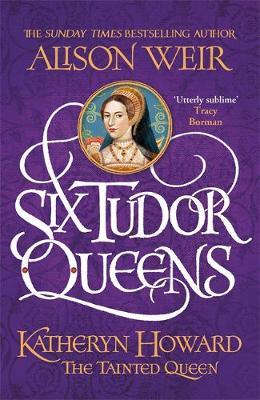Mark your calendars for August 6th. That’s when Alison Weir’s newest historical fiction novel – Katheryn Howard: The Tainted Queen – will be available in bookshops and online. Better still, preorder it now and you’ll be among the first to have it.
Though some describe Weir’s non-fiction as “popular” history (she even uses the term herself in the bio on her website), to my mind, a better characterization is “approachable.” There is no lack of rigor in her research and her sources are scrupulously documented. But her writing style makes even details like household accounts or where a queen was lodging on a particular date into an interesting narrative. And she doesn’t shy away from considering potentially conflicting evidence and making her own, well-informed assessments.

Innocent Traitor (2006) marked the first time Weir blended her imagination with her remarkable depth of knowledge in a published work of fiction. And she’s been publishing fiction and non-fiction side-by-side ever since.
We’re extremely fortunate that she was willing to spend the time to share some of her thoughts and insights with our community.
Q: Few historical writers have achieved your degree of success in both fiction and non-fiction. You’ve had quite a journey from writing novels to becoming famous with your non-fiction histories to returning to novels. What has the ride been like from a personal perspective? And, naturally, the corollary question is, which form do you enjoy most, just for the sheer pleasure of writing?
A: I’m soon to publish my thirtieth book – and I’m still pinching myself! After suffering several rejections, I never thought I would get into print. And then, seventeen years later, to begin publishing fiction as well – that was fantastic, especially as I only wrote my first novel as a hobby, just to see if I could write fiction. It’s been a large learning curve. I’ve been fortunate enough to have wonderful editors, and I have learned something from every book. I enjoy writing both genres; I just love writing.
Q: I was intrigued by your juxtaposition of the two Katherines in A Dangerous Inheritance. What was your inspiration to blend two eras more than a century apart into a single narrative?
A: Originally, this novel was going to be called ‘The Prince from the Tower’, and it was going to tell the story of Richard, Duke of York, the younger of the Princes in the Tower, on the premise that he really was the pretender Perkin Warbeck. But I couldn’t make it work. The thugs who had murdered his brother were hardly likely to have heeded his pleas and let him live. So I cast around for another angle and began to wonder what Richard III’s bastard daughter made of the mystery of the Princes? Did it trouble her that her father was believed to have murdered them? And what was her life like after his death, when a hostile regime took over? Then it occurred to me that Katherine Grey, like Katherine Plantagenet, married into the Herbert family. There was my link, and my imagination took flight after that. It’s my favourite of all the novels I’ve written.
Q: What’s one of the more curious, surprising, or maybe even peculiar things you’ve discovered when doing research for a story?
A: When researching The Lady in the Tower: The Fall of Anne Boleyn, I found good sources that enabled me to write a new narrative of her fall. I’ve pinpointed likely causes for the deaths of Elizabeth of York and Jane Seymour; it wasn’t puerperal fever, as many think. I’ve found evidence that Anne of Cleves may have had a hidden private life. And, recently, I’ve discovered that, in 1253, Henry III’s Queen, Eleanor of Provence, was the first to summon a representational Parliament, with two knights from every shire, eleven years before Simon de Montfort did so, although he is usually credited with making this move towards democracy.
Q: Some of the most fascinating historical books I’ve read center around lesser characters in the pageant of history – something you did in both Innocent Traitor and A Dangerous Inheritance. Do you have any thoughts on how to discover secondary players who can be interesting in their own right and also allow the author to explore events from a different perspective?
A: I’m always building up info about lesser characters when I do my research, so that I can flesh them out in the novel. It’s important to do that to bring them to life, and from a historical point of view. When, for example, I researched my biography of Mary Boleyn, I was able to write a completely new narrative about her, because so much of what was written about her (by me included) was based on historical ‘urban legends’. And, of course, this new perspective on her had an impact on my understanding of Anne Boleyn. So subsidiary characters are very important.
Q: In your advice to writers on “The History Quill,” you said “Appraise your subjects in the context of their own age, not this one. Don’t impose modern values retrospectively.” I couldn’t agree more, despite today’s tendency to do otherwise. What words of encouragement might you have for writers who feel hesitant to let characters “behave badly” and society “look the other way” – or even applaud? (And I’m talking about the whole range of behaviors from atrocities to political machinations to sexual behavior to religious persecution to . . .)
A: I always write my historical novels from the heroine’s point of view, so I have to help the reader see why she might behave badly and arrive at a more sympathetic portrayal. It’s not a whitewash – it’s seeing things from her perspective. But there are difficult areas due to modern sensibilities. In medieval and Tudor times, for example, the ages at which the Church permitted a married couple to cohabit were 12 for girls and 14 for boys. We would see that as underage sex or paedophilia and react accordingly! Many believe that Henry VIII’s fifth wife, Katheryn Howard, was only fifteen when he married her, and that she had already had two sexual affairs. The evidence suggests that she was actually nineteen when she wed the King, and both I and my publishers were rather relieved about that. In regard to the advice requested above, I do feel strongly that, if the evidence is there, you should use it.
Q: Do you have a favorite (or small group of favorites) among the historical figures you’ve written about?
A: It would have to be Elizabeth I or Eleanor of Aquitaine, admirable, strong women with towering reputations.
Q: I absolutely love the Miscellany page of your website. Is there any possibility we might see Lady Katherine Gordon’s story in print? Any hint you’re willing to drop about what might be coming next from your prolific pen?
A: I wish! I submitted the proposal this year, among about a dozen ideas for novels, but my publishers chose three other subjects and another book, to be announced soon. Sorry, I’m not allowed to reveal them.
New York Times best-selling author Alison Weir first started writing and researching at the age of fourteen. Her first book, Britain’s Royal Families, was published in 1989, followed two years later by what may be the most famous of her non-fiction works, The Six Wives of Henry VIII. She turned her hand to fiction with Innocent Traitor, the story of Lady Jane Grey, in 2006 and has been publishing both fiction and non-fiction simultaneously since then.
Her latest work of historical fiction, Katheryn Howard: The Tainted Queen, is available for pre-order now and will be released on August 6, 2020.

Pamela Taylor’s inspiration for her first book turned out to be that final straw that pushed her to leave the corporate world behind for the world of words and imagination. Now an author and an editor, she loves helping others polish their stories almost as much as she enjoys writing her own. She’s a member of the DFW Writers Workshop and the Editorial Freelancers Association and is in her fourth year on the judges panel for the Ink & Insights Contest. You can learn more about her at https://pamela-taylor.com, and about her editing services at editing4you.com.







